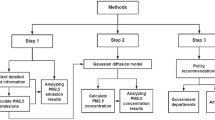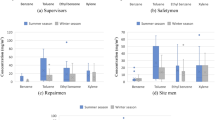Abstract
To address the knowledge gaps regarding inhalation exposure of flight crew to polybrominated diphenyl ethers (PBDEs) on airplanes, we measured PBDE concentrations in air samples collected in the cabin air at cruising altitudes and used Bayesian Decision Analysis (BDA) to evaluate the likelihood of inhalation exposure to result in the average daily dose (ADD) of a member of the flight crew to exceed EPA Reference Doses (RfDs), accounting for all other aircraft and non-aircraft exposures. A total of 59 air samples were collected from different aircraft and analyzed for four PBDE congeners—BDE 47, 99, 100 and 209 (a subset were also analyzed for BDE 183). For congeners with a published RfD, high estimates of ADD were calculated for all non-aircraft exposure pathways and non-inhalation exposure onboard aircraft; inhalation exposure limits were then derived based on the difference between the RfD and ADDs for all other exposure pathways. The 95th percentile measured concentrations of PBDEs in aircraft air were <1% of the derived inhalation exposure limits. Likelihood probabilities of 95th percentile exposure concentrations >1% of the defined exposure limit were zero for all congeners with published RfDs.
This is a preview of subscription content, access via your institution
Access options
Subscribe to this journal
Receive 6 print issues and online access
$259.00 per year
only $43.17 per issue
Buy this article
- Purchase on Springer Link
- Instant access to full article PDF
Prices may be subject to local taxes which are calculated during checkout

Similar content being viewed by others
References
Lyon R.E. Nonhalogen Fire-Resistant Plastics for Aircraft Interiors. Federal Aviation Administration, Springfield, VA, 2008.
La Guardia M.J., Hale R.C., and Harvey E. Detailed polybrominated diphenyl ether (PBDE) congener composition of the widely used penta-, octa-, and deca-PBDE technical flame-retardant mixtures. Environ Sci Technol 2006: 40 (20): 6247–6254.
Harrad S., and Diamond M. New directions: exposure to polybrominated diphenyl ethers (PBDEs) and polychlorinated biphenyls (PCBs): current and future scenarios. Atmos Environ 2006: 40 (6): 1187–1188.
Allen J.G., McClean M.D., Stapleton H.M., and Webster T.F. Linking PBDEs in house dust to consumer products using X-ray fluorescence. Environ Sci Technol 2008a: 42 (11): 4222–4228.
Allen J.G., McClean M.D., Stapleton H.M., and Webster T.F. Critical factors in assessing exposure to PBDEs via house dust. Environ Int 2008b: 34 (8): 1085–1091.
Christiansson A., Hovander L., Athanassiadis I., Jakobsson K., and Bergman A. Polybrominated diphenyl ethers in aircraft cabins — A source of human exposure? Chemosphere 2008: 73 (10): 1654–1660.
Diamond M.L., Gingrich S.E., Fertuck K., McCarry B.E., Stern G.A., and Billeck B., et al. Evidence for organic film on an impervious urban surface: characterization and potential teratogenic effects. Environ Sci Technol 2000: 34: 2900–2908.
Harrad S., Hazrati S., and Ibarra C. Concentrations of polychlorinated biphenyls in indoor air and polybrominated diphenyl ethers in indoor air and dust in Birmingham, United Kingdom: implications for human exposure. Environ Sci Technol 2006: 40 (15): 4633–4638.
Lagalante A.F., Oswald T.D., and Calvosa F.C. Polybrominated diphenyl ether (PBDE) levels in dust from previously owned automobiles at United States dealerships. Environ Int 2009: 35 (3): 539–544.
Schecter A., Papke O., Harris T.R., Tung K.C., Musumba A., and Olson J., et al. Polybrominated diphenyl ether (PBDE) levels in an expanded market basket survey of U.S. food and estimated PBDE dietary intake by age and sex. Environ Health Perspect 2006: 114 (10): 1515–1520.
Fraser A.J., Webster T.F., and McClean M.D. Diet contributes significantly to the body burden of PBDEs in the general US population. Environ Health Perspect 2009: 117 (10): 1520–1525.
Johnson P.I., Stapleton H.M., Slodin A., and Meeker J.D. Relationships between polybrominated diphenyl ether concentrations in house dust and serum. Environ Sci Technol 2010: 44 (14): 5627–5632.
Lorber M. Exposure of Americans to polybrominated diphenyl ethers. J Expo Sci Environ Epidemiol 2008: 18 (1): 2–19.
Webster T., Vieira V., and Shecter A. Estimating exposure to PBDE-47 via air, food and dust using Monte Carlo methods. Organohalogen Compd 2005: 67: 505–508.
Wu N., Herrmann T., Paepke O., Tickner J., Hale R., and Harvey L.E., et al. Human exposure to PBDEs: associations of PBDE body burdens with food consumption and house dust concentrations. Environ Sci Technol 2007: 41 (5): 1584–1589.
Birnbaum L.S., and Staskal D.F. Brominated flame retardants: cause for concern? Environ Health Perspect 2004: 112 (1): 9–17.
Darnerud P.O., Eriksen G.S., Johannesson T., Larsen P.B., and Viluksela M. Polybrominated diphenyl ethers: occurrence, dietary exposure, and toxicology. Environ Health Perspect 2001: 109: 49–68.
McDonald T.A. A perspective on the potential health risks of PBDEs. Chemosphere 2002: 46 (5): 745–755.
Schreiber T., Gassmann K., Götz C., Hübenthal U., Moors M., and Krause G., et al. Polybrominated diphenyl ethers induce developmental neurotoxicity in a human in vitro model: evidence for endocrine disruption. Environ Health Perspect 2009: 118 (4): 572–578.
Chao H.-R., Wang S.-L., Lee W.-J., Wang Y.-F., and Papke O. Levels of polybrominated diphenyl ethers (PBDEs) in breast milk from central Taiwan and their relation to infant birth outcome and maternal menstruation effects. Environ Int 2007: 33 (2): 239.
Chevrier J., Harley K.G., Bradman A., Gharbi M., Sjodin A., and Eskenazi B. Polybrominated diphenyl ether (PBDE) flame retardants and thyroid hormone during pregnancy. Environ Health Perspect 2010: 118 (10): 1444–1449.
Hardell L., van Bavel B., Lindstrom G., Eriksson M., and Carlberg M. In utero exposure to persistent organic pollutants in relation to testicular cancer risk. Int J Androl 2006: 29: 228–234.
Harley K.G., Marks A.R., Chevrier J., Bradman A., Sjodin A., and Eskenazi B. PBDE concentrations in women's serum and fecundability. Environ Health Perspect 2010: 118 (5): 699–704.
Herbstman J.B., Sjödin A., Kurzon M., Lederman S.A., Jones R.S., and Rauh V., et al. Prenatal exposure to PBDEs and neurodevelopment. Environ Health Perspect 2010: 118 (5): 712–719.
Meeker J.D., Johnson P.I., Camann D., and Hauser R. Polybrominated diphenyl ether (PBDE) concentrations in house dust are related to hormone levels in men. Sci Total Environ 2009: 407 (10): 3425–3429.
Stapleton H.M., Eagle S., Anthopolos R., Wolkin A., and Miranda M.L. Associations between polybrominated diphenyl ether (PBDE) flame retardants, phenolic metabolites, and thyroid hormones during pregnancy. Environ Health Perspect 2011: 119 (10): 1454–1459.
Gerecke A. Brominated flame retardants in settled dust of a commercial aircraft. Fourth International Workshop on Brominated Flame Retardants. Amsterdam, The Netherlands, 2007.
Schecter A., Smith S., Haffner D., Colacino J., Malik N., and Patel K., et al. Does flying present a threat of polybrominated diphenyl ether exposure? J Occup Environ Med 2011: 52 (12): 1230–1235.
USEPA.. Exposure factors handbook. National Center for Environmental Assessment, Washington, DC, 1997.
USEPA.. PCB Exposure Estimation Tool, version 1.1. http://www.epa.gov/pcbsincaulk/maxconcentrations.htm(Excel file available here: www.pcbinschools.org/PCBs-SchoolsDose_10-2-09_v1-1.xls); 2010.
Allen J.G., McClean M.D., Stapleton H.M., Nelson J.W., and Webster T.F. Personal exposure to polybrominated diphenyl ethers (PBDEs) in residential indoor air. Environ Sci Technol 2007: 41 (13): 4574–4579.
CARB. California Air Resources Board.. Near-Source Ambient Air Monitoring of Polybrominated Diphenyl Ethers. Department of Environmental Toxicology, Davis, CA, 2005.
USEPA.. Toxicological Review of 2,2′,4,4′-tetrabromodiphenyl ether (BDE 47): in support of summary information on the Integrated Risk Information System. posted onwww.epa.gov/iris, 2008a.
USEPA.. Toxicological Review of 2,2′,4,4′,5-pentabromodiphenyl ether (BDE 99): in support of summary information on the Integrated Risk Information System. posted onwww.epa.gov/iris, 2008b.
USEPA.. Toxicological Review of decabromodiphenyl ether (BDE 209): in support of summary information on the Integrated Risk Information System. posted onwww.epa.gov/iris, 2008c.
Hewett P., Logan P., Mulhausen J., Ramachandran G., and Banerjee S. Rating exposure control using Bayesian decision analysis. J Occup Environ Hyg 2006: 3 (10): 568–581.
AIHA.. Mathematical Models for Estimating Occupational Exposures to Chemicals, 2nd edn. AIHA Press, Fairfax, VA, 2009.
AIHA.. A Strategy for Assessing and Managing Occupational Exposures, 3rd edn. AIHA Press, Fairfax, VA, 2006.
Pettersson-Julander A., van Bavel B., Engwall M., and Westberg H. Personal air sampling and analysis of polybrominated diphenyl ethers and other bromine containing compounds at an electronic recycling facility in Sweden.[see comment]. J Environ Monit 2004: 6 (11): 874–880.
Muenhor D., Harrad S., Ali N., and Covaci A. Brominated flame retardants (BFRs) in air and dust from electronic waste storage facilities in Thailand. Environ Int 2010: 36 (7): 690–698.
Sjödin A., Carlsson H., Thuresson K., Sjolin S., Bergman A., and Ostman C. Flame retardants in indoor air at an electronics recycling plant and at other work environments. Environ Sci Technol 2001: 35 (3): 448–454.
Birnbaum . Environmental chemicals: evaluating low-dose effects. Environ Health Perspect 2012: 120 (4): A143–A144.
Vandenberg L.N., Colborn T., Hayes T.B., Heindel J.J., Jacobs D.R., Lee D-H. et al. Hormones and endocrine disrupting chemicals: low dose effects and non-monotonic dose responses. Endocr Rev 2012: e-pub ahead of print 14 March 2012.
Offenberg J.H., Stapleton H.M., Stryner M.J., and Lindstrom A.B. Polybrominated diphenyl ethers in US soils 2006. Presented at Dioxin 2006: August 21–25, Oslo, Norway. Abstract available at http://www.dioxin2006.org.Summary.
Cahill T.M., Groskova D., Charles M.J., Sanborn J.R., Denison M.S., and Baker L. Atmospheric concentrations of polybrominated diphenyl ethers at near-source sites. Environ Sci Technol 2007: 41 (18): 6370–6377.
Harrad S., Vijesekera R., Hunter S., Halliwell C., and Baker R. Preliminary assessment of U.K. human dietary and inhalation exposure to polybrominated diphenyl ethers. Environ Sci Technol 2004: 38: 2345–2350.
Wilford B.H., Harner T., Zhu J., Shoeib M., and Jones K.C. Passive sampling survey of polybrominated diphenyl ether flame retardants in indoor and outdoor air in Ottawa, Canada: implications for sources and exposure. Environ Sci Technol 2004: 38 (20): 5312–5318.
Acknowledgements
This study was funded by the US Federal Aviation Administration (FAA) Office of Aerospace Medicine through the National Air Transportation Center of Excellence for Airliner Cabin Environment Research (ACER)/Research in the Intermodal Transport Environment (RITE), Cooperative Agreements 07-C-RITE-HU and 04-C-ACE-HU. Although the FAA has sponsored this project, it neither endorses nor rejects the findings of this research. Results of Cooperative Research between the American Society of Heating, Refrigerating and Air-Conditioning Engineers, and Battelle Memorial Institute. We thank the participating airlines for their invaluable support.
Author information
Authors and Affiliations
Corresponding author
Ethics declarations
Competing interests
The authors declare no conflict of interest.
Rights and permissions
About this article
Cite this article
Allen, J., Sumner, A., Nishioka, M. et al. Air concentrations of PBDEs on in-flight airplanes and assessment of flight crew inhalation exposure. J Expo Sci Environ Epidemiol 23, 337–342 (2013). https://doi.org/10.1038/jes.2012.62
Received:
Accepted:
Published:
Issue Date:
DOI: https://doi.org/10.1038/jes.2012.62
Keywords
This article is cited by
-
PBDE flame retardants, thyroid disease, and menopausal status in U.S. women
Environmental Health (2016)



